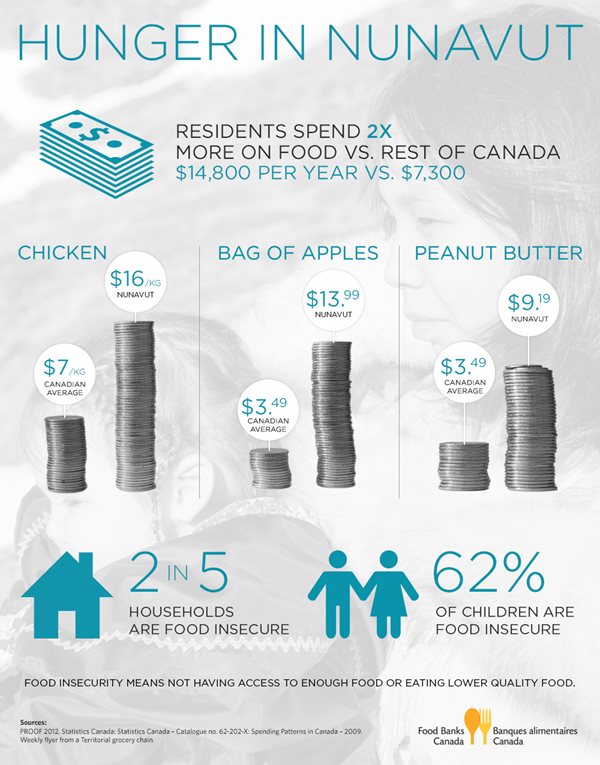This week’s infographic, published by Food Banks Canada, takes a look at food insecurity in Nunavut. Food Banks Canada is a non-profit organization that works to support a network food banks, food agencies and other groups that function at the community level to offer assistance and support to families and individuals experiencing food insecurity. According to the organization’s website, this network assists 850,000 Canadians who are forced to rely on food banks. The organization aids its partners in raising funds, awareness, and influencing policy in hopes of finding short and long-term solutions to hunger.
The infographic states that Nunavut residents spend more than twice as much on food than other Canadians. This is a contributing factor to why an estimated two in five households, and 62% of children, are considered to be food insecure. The importance of good nutrition in healthy development is difficult to overstate. Malnutrition during the early years of life has been linked to negative performance in later years, including adulthood. This means that children who are unable to access nutritious foods face both short and long-term disadvantages compared to youth who have access to nutritious foods.
The infographic defines food insecurity as not having access to enough food or eating lower quality food. Food insecurity is a problem in all three Canadian territories. A 2012 report by PROOF states that in Nunavut, the Yukon and the Northwest Territories, 20% of households either eat lower quality food or skip meals because they are unable to afford better food. The territories have also seen a 247% increase in food bank use since 2008.
It is important to keep in mind that food insecurity in Nunavut is about much more than just the price of food. Food insecurity is inextricably linked to other social determinants of health, such as poor employment outcomes, poverty, and the cost of housing. Income is an important determinant of access to food, and according to figures reported by Statistics Canada, families living in Nunavut had the lowest median income out of all Canadian provinces and territories in 2013. Furthermore, Nunavut has some of the country’s highest core housing needs. Renters in Nunavut’s capital, Iqaluit, paid an average of $2,478 a month in the private market for a two-bedroom apartment.
Food Banks Canada has put forward several recommendations in their HungerCount 2015 report to improve food security in Nunavut. These include:
- Replacing the current system of social assistance with a basic income that is tied to the regional costs of living.
- Increasing opportunities for individuals living in the territories to have input on what food items are subsidized by government-funded programs.
- Expand community knowledge of traditional foods in a changing climate.
- Enhancing government initiatives, at the federal and territorial level, to address the structural causes of food insecurity.


